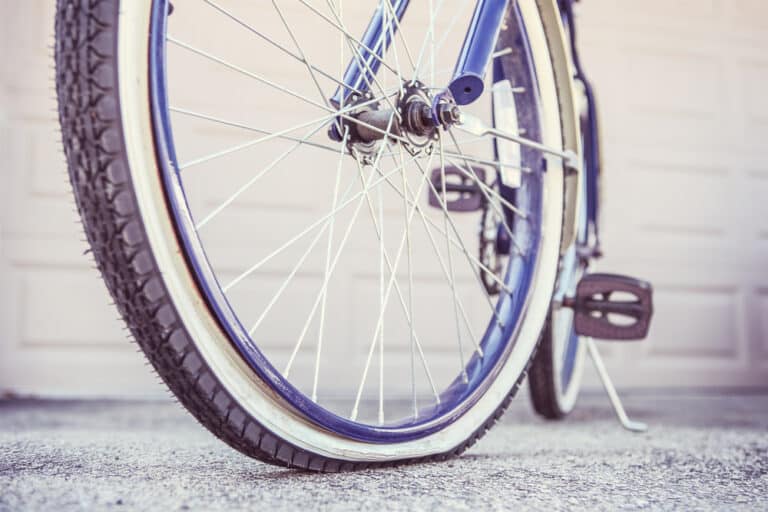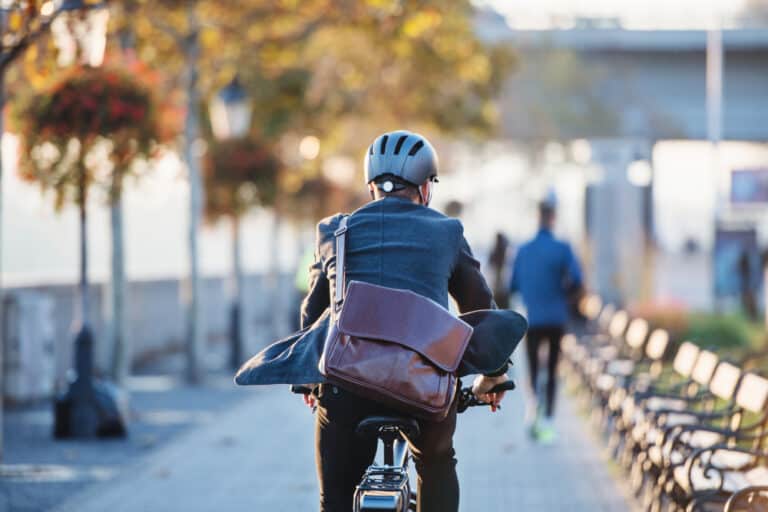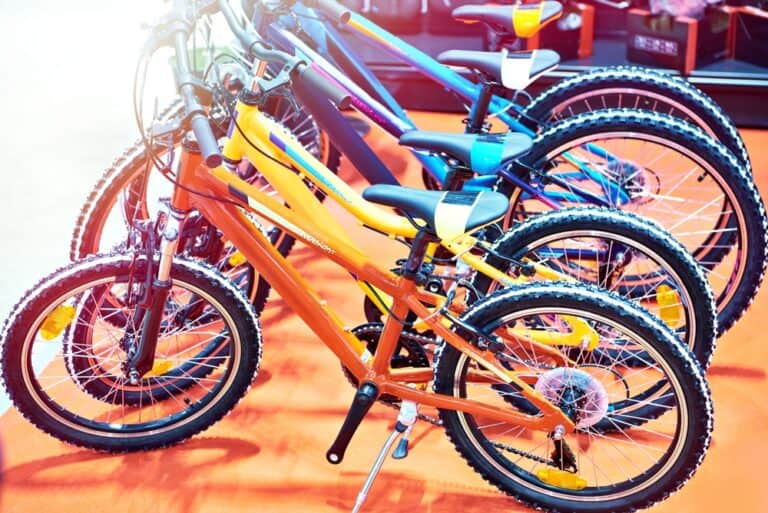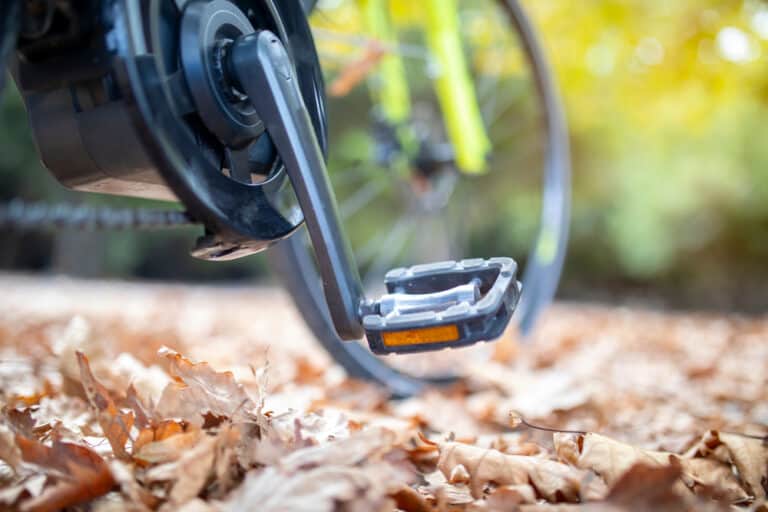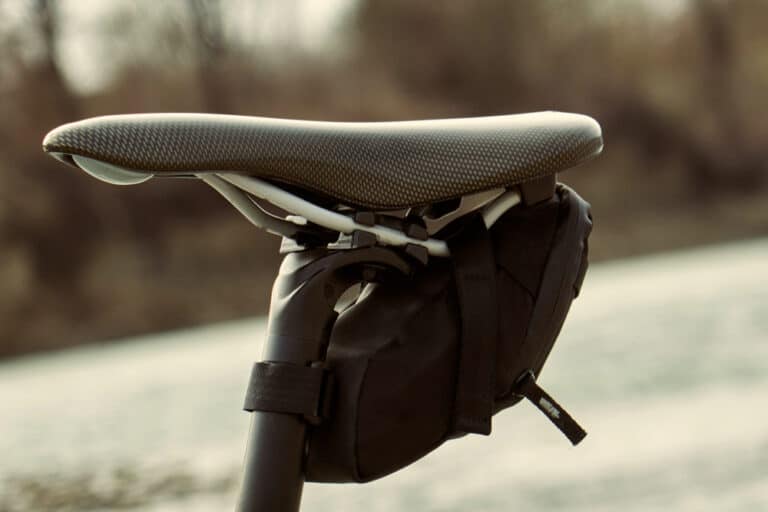Ride A Bike At Night

There are many good reasons why you ride a bike at night. You might prefer it to daytime riding, or maybe you just don’t have the time during daylight hours. Many people ride a bike to work and back home again after clocking out, so they have little choice but to ride at night. And if it’s your only means of transport, a trip to the store will also find you riding after the sun goes down.
If you ride a bike at night, whatever the reason, there are safety concerns you need to be aware of and precautions you can take to keep yourself safe, over and above those which all cyclists need to practice. Cycling on a public road is never totally risk-free, but those risks can be minimized.
It’s certainly not only those who have to ride at night that do it. Many riders prefer the darkened streets and even intrepid cyclists who go mountain biking under the stars. We’ll examine the pros and cons of riding at night, how to prepare yourself and your bike and check out some of the best tips for those who ride at night.
What Are The Dangers Of Riding A Bike At Night?
Statistically, the roads are generally more dangerous at night, with approximately 62% of all road fatalities occurring between sunset and sunrise, even though fewer vehicles are on the road.
- Riders are not as visible – even with reflective clothing and a well-lit bike, motorists will not pick you up visually until you’re within range of their headlights. If they’re driving fast or not concentrating, they may be too close to take safe, avoiding action.
- The rider’s vision is limited if they’re on an unlit road to what is within the range of their own headlight. Road hazards such as potholes or pedestrians walking along the road may be just about invisible until it’s too late to avoid them.
- Headlights of approaching vehicles may blind you temporarily, but long enough to cause an accident.
- Your reaction times are not as quick at night, so responding to a dangerous situation may be too slow to prevent an accident.
- Driving under the influence is more prevalent at night, so while you may be sober and alert, the other driver may not be.
- Mechanical problems may leave you stranded at night, particularly if you’re in an isolated spot with no one to assist you.
What Are The Benefits Of Riding A Bike At Night?
There’s no argument that it’s riskier to ride a bike at night, but many cyclists will tell of the unique pleasure, the unbeatable feeling of concentrated sensations that night riding brings.
Apart from these benefits, there are some practical advantages to consider.
- There’s a lot less traffic on the road. During the day, you compete for road space with commuters hurrying to appointments, trucks on a tight delivery schedule, and a road full of stressed drivers.
- When you ride a bike at night, you are more aware of vehicles approaching you from behind, which allows you to move to give them maximum space to pass you.
- There are no visual distractions – your view is restricted to the illuminated area in front of you. So while there is a sense of isolation from external distractions, you can concentrate totally on your cycling – it’s easier to get into what is termed the flow state where you are totally absorbed by your present activity and feeling no stress, either physical or mental.
- If you have a hectic schedule during the day or working office hours, it’s possible that you only get to ride at weekends. By riding at night, you get to exercise daily if you choose, your fitness levels will improve, and you’ll also find you’re much less stressed at the end of the day. That means you’ll sleep better, giving you more energy the next day.
- People who try to get a ride in first thing in the morning, like those who go for a gym workout, get to work physically tired and probably stressed by the rush to exercise, shower, change clothes, and still get to work on time. That’s no way to start the day.
- Because there’s far less traffic on the road, it’s possible to choose routes that aren’t safe during the day. New experiences, finding new places to visit over weekends, and getting out of your daily rut, are all possibilities when you have the road to yourself (almost, anyway) once everybody else is home.
Enthusiasts who have been riding for years during the day and over weekends find that night riding brings a whole new perspective to their cycling. Their only regret is that they didn’t discover the joys of night riding earlier.
Preparing Your Bike To Ride At Night
During a day ride, if your bike gives in, there’s usually a fellow cyclist to assist in getting you going again or a garage where you can get the bike fixed or a puncture repaired. At night you’re more than likely going to be stranded unless you follow some basic rules.
Preventive Maintenance On Your Bike
Daily, or at least before heading out for a night ride, carry out a thorough check on every part of your bike – check tires for any potential punctures (like thorns in the tread), ensure the chain is in good condition and oiled, check brakes and brake cables, gears and selection mechanism, lights, and batteries.
You should carry a basic toolkit with you on your night rides, either in your backpack or in a saddle bag. This kit should include a spare inner tube, a pump, and a small multitool.
Maximize Your Bike’s Visibility
The key to safe night riding is to see and be seen. Both these aspects of visibility will be served by fitting good quality lights.
Headlights For Road Bikes Vs. Mountain Bikes
If you’re on a road bike and riding in mainly urban areas on lit roads, a light of between 500 and 800 lumens will be sufficient, and a narrow beam is perfectly acceptable.
An important additional safety factor for urban riding is using a headlamp with a flashing mode – it’s effective in making you far more visible to oncoming traffic, particularly at intersections where most accidents occur.
Mountain bikers need a headlamp with a wider beam, and strength of 1600 lumens is recommended. With uneven terrain and all sorts of obstacles on an unlit trail, your headlight is your most crucial piece of equipment so buy the best you can afford.
Taillights Are Not An Optional Extra
Your bike must be visible to vehicles approaching from behind you and to fellow riders if you’re mountain biking in a group. A single red light behind the bike will adequately serve that purpose. Again, a flashing light is much more effective than a standard one.
Helmet Lamps Give You A Heads Up
While a headlight fixed to your handlebars will light the area ahead, a helmet light obviously points in the direction you’re looking, so it is a very valuable aid to visibility. Especially if you’re on a dark trail, a helmet lamp is even more effective than anything else.
Reflective Tape, Wheel Lights, And Other Bling
You can have a lot of fun keeping safe by adding all kinds of visibility-enhancing “bling” to your bike. Tape up the frame with colored reflective tape or decorate your wheels with a string of lights designed specifically for the purpose. Ensure they are well secured and don’t interfere with the bike’s mechanisms.
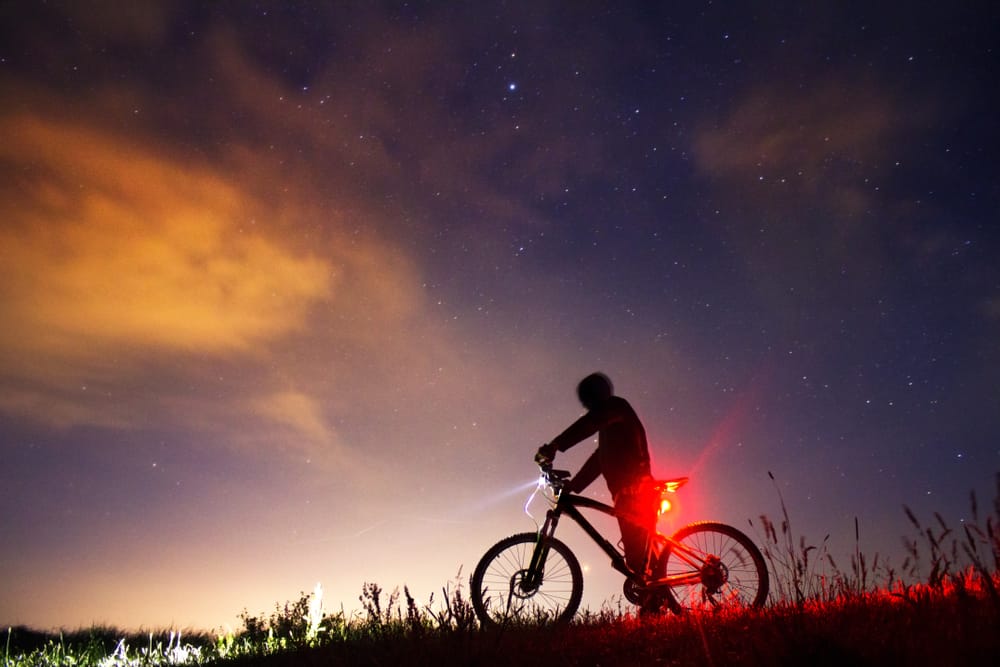
Make Yourself As Visible As Your Bike
Add to your overall visibility by wearing clothing that can be clearly seen on a dark road.
- Don’t wear dark clothing at night – it will make you almost invisible. If you don’t have the budget for specialized gear, at least wear light, bright clothing.
- If you can afford it, reflective jackets and jerseys could be lifesavers. An option would be to add reflective tape to your tops and cycling pants, as well as to your gloves and helmet.
- Wear ankle lights – these strap-on lamps are effective because they move with your pedaling motion and are more visible than static lights.
Some Tips For Safe Riding At Night
Apart from the vital aspect of visibility, there are some common-sense tips that we sometimes need reminding of before we set out on a night ride:
- Check the weather – if you’reriding for pleasure or training rather than from necessity, take a minute to ensure that you’re not going to get caught in a downpour or other hazardous weather conditions.
- Charge up your batteries – ensure that all your batteries are fully charged so that you don’t run out of lights before you get home. If you’re on a long ride, pack a few spare batteries as a backup measure.
- Avoid cycling alone – ideally, cycle in a group or with a friend so that if anything goes wrong, there’s someone to assist you or at least call for assistance.
- Pack a mobile phone – talking of calling for assistance, you will need a phone! Also, it’s useful for checking your position if you get lost or want to find an alternative route for any reason.
- Wear night vision glasses – clear or specially tinted lenses will improve your night vision, reduce glare from oncoming vehicles, and protect your eyes from bugs and other objects.
- Plan Your Route – routes you know so well can take on a whole new feel at night, so know exactly where you’re going. It’s also wise to let someone else know your plans so they know where to check on you if you’re not home on time.
Conclusion
Converts to night riding are unanimous in that it’s far more invigorating, exciting, and pleasurable than riding during the day. There are good reasons for that, and we’ve mentioned a few to help you make the change.
There’s definite evidence that riding a bike at night is riskier than during the day, so whether you’re doing it by choice or necessity, we’ve also highlighted the steps you must take to reduce that risk, minimize the chances of an unfortunate accident and keep experiencing the pure enjoyment of cycling in the dark.

